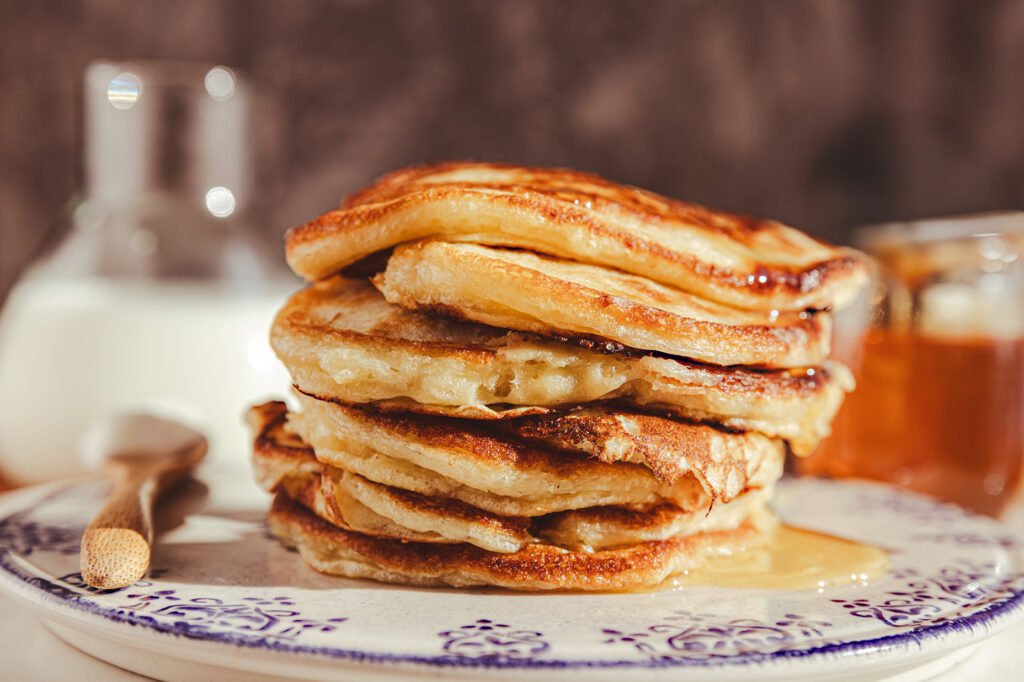The History of Pancakes: A Delicious Journey Through Time
Pancakes are one of the oldest and most beloved breakfast dishes, with a history that spans thousands of years and crosses many cultures. Their simplicity and versatility have made them a timeless comfort food. Let’s explore how pancakes have evolved through history.

Ancient Origins
- Prehistoric Beginnings:
Pancakes are thought to be one of the earliest forms of bread. Archaeological evidence suggests that prehistoric humans made flat cakes by mixing water with ground grains and cooking them over hot stones. - Otzi the Iceman (3300 BCE):
The discovery of Otzi, a well-preserved mummy from the Copper Age, revealed that his last meal included a type of pancake made from einkorn wheat and cooked over an open flame.
Pancakes in Ancient Civilizations
- Ancient Greece and Rome:
In Ancient Greece, pancakes (called “tagenites”) were made from wheat flour, olive oil, honey, and curdled milk. The Romans enjoyed a similar dish called “alita dolcia,” sweetened with honey and flavored with spices. - India:
In India, flatbreads like “dosa” and “uttapam,” made from fermented rice and lentil batter, have been staples for centuries. These savory pancakes are still widely enjoyed today.
Medieval Europe
- During the Middle Ages, pancakes became a popular dish across Europe. They were made with ingredients like flour, eggs, milk, and spices. Pancakes were often associated with festivities, particularly Shrove Tuesday (Pancake Day)—a day to use up rich ingredients like butter and eggs before the fasting season of Lent.
The Renaissance and Beyond
- European Variations:
By the Renaissance, pancakes were a staple in many European countries. The French developed thin crêpes, while the Dutch created “pannekoeken,” which could be sweet or savory. In Russia, blini—small, yeasted pancakes—became a traditional dish served with sour cream or caviar. - Introduction to the Americas:
European settlers brought pancake recipes to the Americas, where they adapted them using local ingredients like cornmeal. Native Americans also had their own versions of pancakes, such as “johnnycakes,” made from ground corn.
Modern Pancakes
- Global Variations:
Pancakes have taken on countless forms around the world:- American Pancakes: Fluffy and thick, often served with butter and maple syrup.
- Japanese Soufflé Pancakes: Extra thick and airy, made with whipped egg whites.
- Ethiopian Injera: A savory, spongy pancake made from teff flour and used as a base for meals.
- Scandinavian Pancakes: Thin and delicate, often served with lingonberry jam.
- Industrial Revolution:
The 19th century saw the rise of ready-made pancake mixes, making it easier for families to prepare pancakes at home. In 1889, Aunt Jemima (now Pearl Milling Company) launched one of the first commercial pancake mixes.
Cultural Significance
Pancakes have become more than just food; they are a symbol of celebration and comfort. From Shrove Tuesday feasts to lazy Sunday breakfasts, pancakes continue to bring people together across the globe.
The history of pancakes is as rich and diverse as the dish itself. From ancient hearths to modern kitchens, pancakes have stood the test of time, adapting to different cultures and tastes. Whether sweet or savory, thick or thin, pancakes remain a universally loved culinary treasure.
Fluffy Yeast Pancakes Recipe
Ingredients (Serves 4)
- 2 cups (250g) all-purpose flour
- 1 ½ teaspoons instant yeast
- 2 tablespoons sugar
- ½ teaspoon salt
- 1 cup (240ml) warm milk (around 110°F/43°C)
- 2 large eggs
- 2 tablespoons melted butter or vegetable oil
- 1 teaspoon vanilla extract (optional)
- Butter or oil for greasing the pan
- Optional toppings: Maple syrup, honey, fresh fruits, or powdered sugar
Instructions
- Activate the Yeast
In a small bowl, mix the warm milk with the sugar and yeast. Let it sit for 5-10 minutes until it becomes frothy. This step ensures the yeast is active. - Mix the Dry Ingredients
In a large bowl, whisk together the flour and salt. - Combine Wet Ingredients
In a separate bowl, beat the eggs and mix them with the melted butter (or oil) and vanilla extract. - Make the Batter
Gradually add the yeast mixture and the egg mixture to the dry ingredients. Stir gently until well combined. The batter will be slightly thick. Cover the bowl with a clean kitchen towel and let it rest in a warm place for 30-45 minutes, allowing the yeast to work its magic. - Heat the Pan
Heat a non-stick skillet or griddle over medium heat and lightly grease it with butter or oil. - Cook the Pancakes
Pour about ¼ cup of batter onto the skillet for each pancake. Cook until bubbles form on the surface and the edges look set (about 2-3 minutes). Flip and cook the other side until golden brown. - Serve Warm
Stack the pancakes, drizzle with syrup, and add your favorite toppings like fresh berries, whipped cream, or even a sprinkle of cinnamon.
Tips for Best Results
- Warm Ingredients: Ensure that the milk and melted butter are warm but not hot to avoid killing the yeast.
- Resting Time: Don’t skip the resting time! It’s essential for the yeast to activate and create fluffy pancakes.
- Gentle Mixing: Avoid overmixing the batter to maintain its airy texture.





